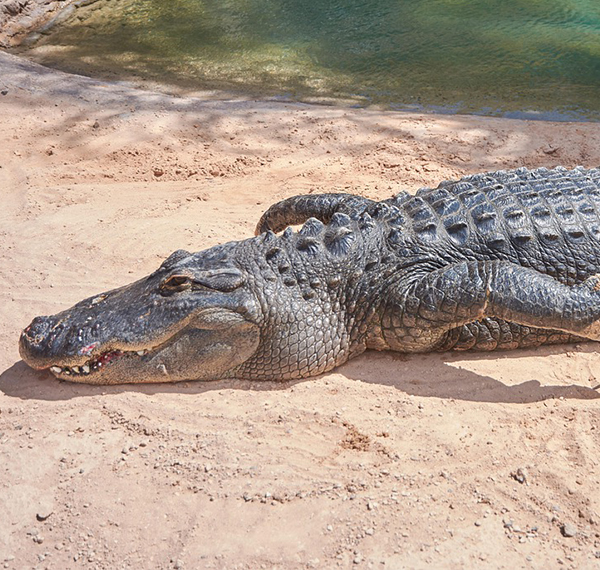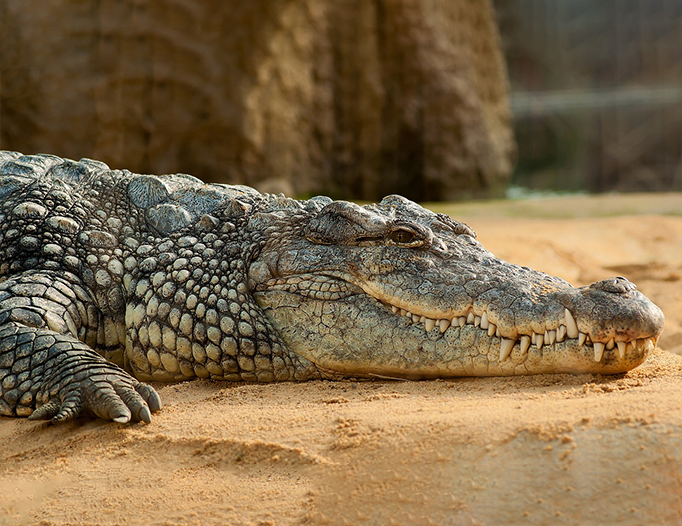Total Weight
Height
Diet
Lifespan
Total Weight
Height
Diet
Lifespan
The Mugger Crocodile, is a vulnerable species primarily found in freshwater habitats across the Indian subcontinent. In Bihar, they mostly found in Gandak river stretch of Valmiki Tiger Reserve and plateau of Kaimur wildlife sanctuary, particularly in Karkatgarh waterfall area.
They are known
for their broad snouts and live in rivers, lakes, and marshes. Mugger crocodiles are opportunistic predators, feeding on fish, amphibians, reptiles, and small mammals.


In Patna Zoo, there is an enclosure dedicated to housing mugger crocodiles. Visitors can observe these vulnerable freshwater crocodiles up close and learn
about their habitat, behavior, and conservation efforts. The enclosure provides a safe and natural environment for the crocodiles to
thrive and educate the public. These reptiles are known for their broad snouts, powerful jaws, and ability to adapt to various
freshwater habitats such as rivers, lakes, and marshes.
Informational boards placed around the enclosure provide valuable insights
into their role in the ecosystem, feeding habits, and threats like habitat destruction and poaching.
Conservation programs aim to raise awareness about protecting these remarkable reptiles. Watching a mugger crocodile bask in the sun or silently glide
through the water is an awe-inspiring experience, making it a must-visit attraction for nature lovers and wildlife enthusiasts.
The Crocodile at Patna Zoo is a fascinating reptile known for its powerful jaws, armored body, and stealthy movements.
Visit their enclosure to witness their unique behavior, basking habits, and swift aquatic maneuvers up close!
| Attribute | Details |
|---|---|
| Weight | Males: Typically weigh between 360 to 450 kg , Females: Usually weigh around 200 to 230 kg |
| Length | Males generally reach 10 to 15 feet, while females are around 8 to 10 feet |
| Diet | Crocodiles eat a mix of fish, birds, mammals, amphibians, reptiles, and carrion (dead animals) |
| Lifespan | In the wild, crocodiles usually live for 35 to 50 years, with even longer lifespans in captivity |
| Conservation Status | Least Concern for some species (like the American crocodile), though other crocodile species are considered more at risk |
| Population in the Wild | Populations are considered stable across much of their range, particularly in southeastern United States |
| Social Structure | Mostly solitary, but they will tolerate other crocodiles in favorable basking spots or rich feeding areas |
| Unique Behavior | Crocodiles are excellent swimmers, using their strong tails to propel through water, and they can stay underwater for long periods |
| Feeding Pattern | They are carnivores, known for being ambush predators, often lurking near or in water to catch prey by surprise |
| Skin Feature | Their bodies are covered in thick, protective scales called scutes, providing armor-like defense |
| Closest Relatives | Closely related to alligators, caimans, and gharials, all of which belong to the Crocodylia order |
Crocodiles are carnivores, meaning their diet mainly consists of meat. They feed on a wide range of animals, including fish, birds, amphibians, reptiles, and mammals. Young crocodiles tend to eat insects, small fish, and amphibians, while adults go after larger prey such as wading birds, deer, wild boar, and even other crocodiles.
As ambush predators, crocodiles hide beneath the water’s surface, often with only their eyes and nostrils visible. They strike swiftly when prey comes close. Crocodiles are also scavengers and will readily feed on carrion (dead animals) if the opportunity arises.
Their powerful jaws and strong teeth allow them to crush bones, shells, and tough hides with ease. Though they prefer fresh kills, they are highly opportunistic hunters and will eat almost anything they can overpower.
Open Now
All visits to Patna Zoo help fund our work both at the zoo and worldwide.